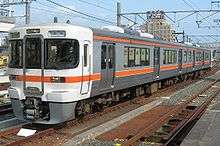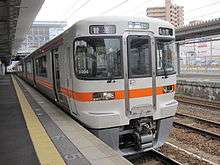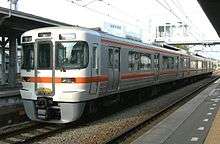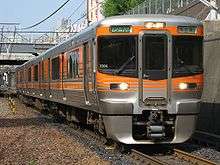313 series
The 313 series (313系, 313-kei) is a DC suburban electric multiple unit (EMU) train type operated by Central Japan Railway Company (JR Central) in Japan since 1999.
| 313 series | |
|---|---|
313-5000 series 6-car set, May 2009 | |
| In service | 1999–Present |
| Manufacturer | Kinki Sharyo, Nippon Sharyo, Tokyu Car Corporation[1] |
| Replaced | 103 series, 113 series, 115 series, 117 series, 119 series, 165 series |
| Constructed | 1999–2014, 2019 |
| Entered service | May 1999 |
| Number built | 541 vehicles |
| Number in service | 539 vehicles |
| Number scrapped | 2 vehicles (accident damage) |
| Formation | 2/3/4/6 cars per trainset |
| Operator(s) | JR Central |
| Depot(s) | Ōgaki, Jinryō, Shizuoka |
| Line(s) served | Tōkaidō Main Line, Chūō Main Line, Shinonoi Line, Shinetsu Main Line Minobu Line, Gotemba Line, Kansai Main Line |
| Specifications | |
| Car body construction | Stainless steel |
| Doors | 3 pairs per side |
| Maximum speed | 130 km/h (80 mph) (313-8000 series) 120 km/h (75 mph) (other series) |
| Traction system | IGBT-VVVF |
| Electric system(s) | 1,500 V DC |
| Current collection method | Overhead catenary |
| Braking system(s) | Dynamic brake, regenerative brake, electronically controlled pneumatic brakes, snow-resistant brake |
| Safety system(s) | ATS-ST, ATS-PT |
| Multiple working | 211/213/311 series |
| Track gauge | 1,067 mm (3 ft 6 in) |
The design was introduced from spring 1999 to replace older 113 and 115 series EMUs.[2]
Variants
| Series | Formation | Line used |
|---|---|---|
| 313-0 series | 4-car | Tōkaidō Main Line (Toyohashi - Maibara) |
| 313-300 series | 2-car | |
| 313-1000 series | 4-car | Chūō Main Line (Nagoya - Nakatsugawa) |
| 313-1300 series | 2-car | Tōkaidō Main Line |
| 313-1500 series | 3-car | Chūō Main Line (Nagoya - Nakatsugawa) Kansai Main Line (Nagoya - Kameyama) |
| 313-1600 series | ||
| 313-1700 series | Iida Line, Chūō Main Line, Kansai Main Line | |
| 313-2300 series | 2-car | Tōkaidō Main Line, Gotemba Line, Minobu Line |
| 313-2350 series | ||
| 313-2500 series | 3-car | Tōkaidō Main Line (Atami - Toyohashi) |
| 313-2600 series | Tōkaidō Main Line, Gotemba Line, Minobu Line | |
| 313-3000 series | 2-car | Kansai Main Line, Chūō Main Line Gotemba Line, Minobu Line |
| 313-3100 series | Gotemba Line, Minobu Line | |
| 313-5000 series | 6-car | Tōkaidō Main Line (Toyohashi - Ōgaki) |
| 313-5300 series | 2-car | Tōkaidō Main Line |
| 313-8000 series | 3-car | Chūō Main Line (Nagoya - Nakatsugawa) |
313-0 series
15 x 4-car sets (60 vehicles) built by Kinki Sharyo, Nippon Sharyo, and Tokyu Car Corporation between July and September 1999 with flip-over transverse seating.[3]
4-car Ōgaki sets Y1 to Y15
| Designation | Mc | T | M | Tc' |
|---|---|---|---|---|
| Numbering | KuMoHa 313 | SaHa 313 | MoHa 313 | KuHa 312 |
313-300 series

16 x 2-car sets (32 vehicles) built by Kinki Sharyo, Nippon Sharyo, and Tokyu Car Corporation in September 1999 with flip-over transverse seating.[3]
2-car Ōgaki sets Y31 to Y46
| Designation | Mc | Tc' |
|---|---|---|
| Numbering | KuMoHa 313-300 | KuHa 312-300 |
313-1000 series
3 x 4-car and 3 x 2-car sets (21 vehicles) built by Nippon Sharyo and Tokyu Car Corporation between February and March 1999 with flip-over transverse seating.[1]
A further seven 4-car sets, J1 to J7, were delivered from Nippon Sharyo to Ōgaki depot between August and October 2010.[4]
4-car Jinryō sets B1 to B5
B1 to B3
| Designation | Mc | T | M | Tc' |
|---|---|---|---|---|
| Numbering | KuMoHa 313-1000 | SaHa 313-1000 | MoHa 313-1000 | KuHa 312 |
B4 to B5
| Designation | Mc | T | M | Tc' |
|---|---|---|---|---|
| Numbering | KuMoHa 313-1100 | SaHa 313-1100 | MoHa 313-1100 | KuHa 312-400 |
4-car Ōgaki sets J1 to J7
| Designation | Mc | T | M | Tc' |
|---|---|---|---|---|
| Numbering | KuMoHa 313-1100 | SaHa 313-1100 | MoHa 313-1100 | KuHa 312-400 |
3-car Jinryō sets B101 to B107
B101 to B103
| Designation | Mc | M | Tc' |
|---|---|---|---|
| Numbering | KuMoHa 313-1500 | MoHa 313-1500 | KuHa 312 |
B104 to B107
| Designation | Mc | M | Tc' |
|---|---|---|---|
| Numbering | KuMoHa 313-1600 | MoHa 313-1600 | KuHa 312-400 |
3-car Jinryō sets B151 to B153
| Designation | Mc | M | Tc' |
|---|---|---|---|
| Numbering | KuMoHa 313-1700 | MoHa 313-1700 | KuHa 312-400 |
313-1300 series

4 x 2-car 4th-batch sets (8 vehicles) were built by Nippon Sharyo in June 2010. The sets are numbered B401 to B404 and allocated to Jinryō depot. All cars feature flip-over transverse seating.[5][6] A further four 2-car sets, numbered B501 to B504, were delivered from Nippon Sharyo to Jinryō depot on 3 August 2011.[7]
2-car Jinryō sets B401–B404, B501–B504
| Designation | Tc' | Mc |
|---|---|---|
| Numbering | KuHa 312-1300 | KuMoHa 313-1300 |
313-2000 series

9 x 2-car and 27 x 3-car sets (99 vehicles) built by Kinki Sharyo and Nippon Sharyo between November 2006 and February 2007 with longitudinal seating.[3]
2-car Shizuoka sets W1 to W9
W1–W2
| Designation | Mc | Tc' |
|---|---|---|
| Numbering | KuMoHa 313-2350 | KuHa 312-2300 |
W3–W9
| Designation | Mc | Tc' |
|---|---|---|
| Numbering | KuMoHa 313-2300 | KuHa 312-2300 |
3-car Shizuoka sets T1 to T17
| Designation | Mc | M | Tc' |
|---|---|---|---|
| Numbering | KuMoHa 313-2500 | MoHa 313-2500 | KuHa 312-2300 |
3-car Shizuoka sets N1 to N10
| Designation | Mc | M | Tc' |
|---|---|---|---|
| Numbering | KuMoHa 313-2600 | MoHa 313-2600 | KuHa 312-2300 |
Interior
- 313-2000 series interior view showing longitudinal seating, January 2007
313-3000 series

12 x 2-car and 16 x 2-car sets (56 vehicles) with fixed transverse seating and longitudinal seating.[2]
2-car Shizuoka sets V1 to V14
V1–V12
| Designation | Mc | Tc' |
|---|---|---|
| Numbering | KuMoHa 313-3000 | KuHa 312-3000 |
V13–V14
| Designation | Mc | Tc' |
|---|---|---|
| Numbering | KuMoHa 313-3100 | KuHa 312-3100 |
2-car Jinryō sets B301 to B316
| Designation | Mc | Tc' |
|---|---|---|
| Numbering | KuMoHa 313-3000 | KuHa 312-3000 |
Interior
- 313-3000 series interior view, January 2007
- 313-3000 series interior view, January 2007
313-5000 series

12 x 6-car sets (72 vehicles) were built by Nippon Sharyo in 2006 with flip-over transverse seating.[1] This was the first conventional (i.e. non-shinkansen) rolling stock to feature yaw dampers between intermediate cars.[2]
Further (4th-batch) sets were delivered in 2010.[6]
6-car Ōgaki sets Y101 to Y113
| Designation | Mc | T | M | T | M | Tc' |
|---|---|---|---|---|---|---|
| Numbering | KuMoHa 313-5000 | SaHa 313-5300 | MoHa 313-5000 | SaHa 313-5000 | MoHa 313-5300 | KuHa 312-5000 |
313-5300 series
One 2-car 4th-batch set was delivered in July 2010 with flip-over transverse seating.[4][6]
2-car Ōgaki sets Z1
| Designation | Mc | Tc' |
|---|---|---|
| Numbering | KuMoHa 313-5300 | KuHa 312-5000 |
313-8000 series

6 x 3-car sets (18 vehicles) with flip-over transverse seating for use on Chūō Main Line Central Liner and Home Liner Nakatsugawa services, built by Kinki Sharyo and Nippon Sharyo between September 1999 and February 2001.[1]
3-car Jinryō sets B201 to B206
| Designation | Mc | M | Tc' |
|---|---|---|---|
| Numbering | KuMoHa 313-8500 | MoHa 313-8500 | KuHa 312-8000 |
See also
- KiHa 25, diesel multiple unit counterpart
References
- JR電車編成表 '07冬号 [JR EMU Formations - Winter 2007]. Japan: JRR. December 2006. ISBN 978-4-88283-046-7.
- "311系・313系 製作の背景と現在までの経緯" [311 & 313 series: Background and developments to present day]. Tetsudō Daiya Jōhō. 38 (304): 12–25. August 2009.
- JR電車編成表 2009夏 [JR EMU Formations - Summer 2009]. Japan: JRR. June 2009. ISBN 978-4-330-06909-8.
- JR電車編成表 2011夏 [JR EMU Formations - Summer 2011]. Japan: JRR. May 2010. ISBN 978-4-330-21211-1.
- 313系1300番台が営業運転を開始 [313-1300 series enters revenue service]. Japan Railfan Magazine Online (in Japanese). Koyusha Co., Ltd. 4 July 2010. Archived from the original on 7 July 2010. Retrieved 6 July 2010.
- "313系4次車 (313 series 4th-batch sets)". Japan Railfan Magazine. 50 (594): 80–81. October 2010.
- 313系1300番台が日本車輌から出場 [313-1300 series delivered from Nippon Sharyo]. Japan Railfan Magazine Online (in Japanese). Japan: Koyusha Co., Ltd. 4 August 2011. Retrieved 6 August 2011.
External links
| Wikimedia Commons has media related to 313 series. |
- JR Central 313 series information (in Japanese)
